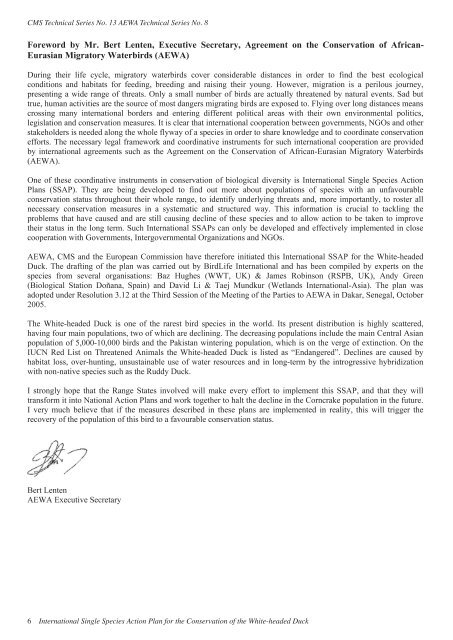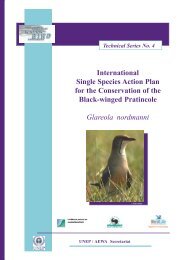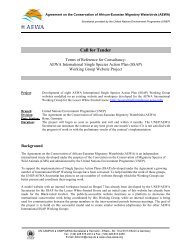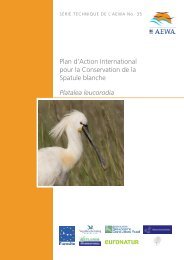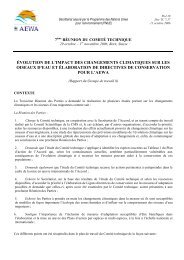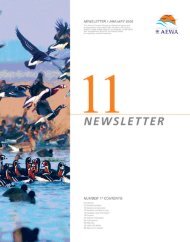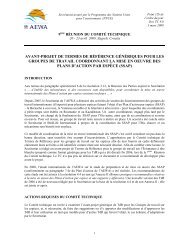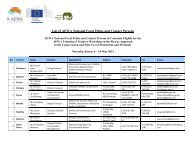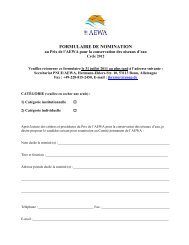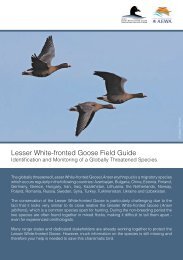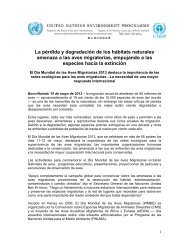International Single Species Action Plan for the Conservation - AEWA
International Single Species Action Plan for the Conservation - AEWA
International Single Species Action Plan for the Conservation - AEWA
Create successful ePaper yourself
Turn your PDF publications into a flip-book with our unique Google optimized e-Paper software.
CMS Technical Series No. 13 <strong>AEWA</strong> Technical Series No. 8<br />
Foreword by Mr. Bert Lenten, Executive Secretary, Agreement on <strong>the</strong> <strong>Conservation</strong> of African-<br />
Eurasian Migratory Waterbirds (<strong>AEWA</strong>)<br />
During <strong>the</strong>ir life cycle, migratory waterbirds cover considerable distances in order to find <strong>the</strong> best ecological<br />
conditions and habitats <strong>for</strong> feeding, breeding and raising <strong>the</strong>ir young. However, migration is a perilous journey,<br />
presenting a wide range of threats. Only a small number of birds are actually threatened by natural events. Sad but<br />
true, human activities are <strong>the</strong> source of most dangers migrating birds are exposed to. Flying over long distances means<br />
crossing many international borders and entering different political areas with <strong>the</strong>ir own environmental politics,<br />
legislation and conservation measures. It is clear that international cooperation between governments, NGOs and o<strong>the</strong>r<br />
stakeholders is needed along <strong>the</strong> whole flyway of a species in order to share knowledge and to coordinate conservation<br />
ef<strong>for</strong>ts. The necessary legal framework and coordinative instruments <strong>for</strong> such international cooperation are provided<br />
by international agreements such as <strong>the</strong> Agreement on <strong>the</strong> <strong>Conservation</strong> of African-Eurasian Migratory Waterbirds<br />
(<strong>AEWA</strong>).<br />
One of <strong>the</strong>se coordinative instruments in conservation of biological diversity is <strong>International</strong> <strong>Single</strong> <strong>Species</strong> <strong>Action</strong><br />
<strong>Plan</strong>s (SSAP). They are being developed to find out more about populations of species with an unfavourable<br />
conservation status throughout <strong>the</strong>ir whole range, to identify underlying threats and, more importantly, to roster all<br />
necessary conservation measures in a systematic and structured way. This in<strong>for</strong>mation is crucial to tackling <strong>the</strong><br />
problems that have caused and are still causing decline of <strong>the</strong>se species and to allow action to be taken to improve<br />
<strong>the</strong>ir status in <strong>the</strong> long term. Such <strong>International</strong> SSAPs can only be developed and effectively implemented in close<br />
cooperation with Governments, Intergovernmental Organizations and NGOs.<br />
<strong>AEWA</strong>, CMS and <strong>the</strong> European Commission have <strong>the</strong>re<strong>for</strong>e initiated this <strong>International</strong> SSAP <strong>for</strong> <strong>the</strong> White-headed<br />
Duck. The drafting of <strong>the</strong> plan was carried out by BirdLife <strong>International</strong> and has been compiled by experts on <strong>the</strong><br />
species from several organisations: Baz Hughes (WWT, UK) & James Robinson (RSPB, UK), Andy Green<br />
(Biological Station Doñana, Spain) and David Li & Taej Mundkur (Wetlands <strong>International</strong>-Asia). The plan was<br />
adopted under Resolution 3.12 at <strong>the</strong> Third Session of <strong>the</strong> Meeting of <strong>the</strong> Parties to <strong>AEWA</strong> in Dakar, Senegal, October<br />
2005.<br />
The White-headed Duck is one of <strong>the</strong> rarest bird species in <strong>the</strong> world. Its present distribution is highly scattered,<br />
having four main populations, two of which are declining. The decreasing populations include <strong>the</strong> main Central Asian<br />
population of 5,000-10,000 birds and <strong>the</strong> Pakistan wintering population, which is on <strong>the</strong> verge of extinction. On <strong>the</strong><br />
IUCN Red List on Threatened Animals <strong>the</strong> White-headed Duck is listed as “Endangered”. Declines are caused by<br />
habitat loss, over-hunting, unsustainable use of water resources and in long-term by <strong>the</strong> introgressive hybridization<br />
with non-native species such as <strong>the</strong> Ruddy Duck.<br />
I strongly hope that <strong>the</strong> Range States involved will make every ef<strong>for</strong>t to implement this SSAP, and that <strong>the</strong>y will<br />
trans<strong>for</strong>m it into National <strong>Action</strong> <strong>Plan</strong>s and work toge<strong>the</strong>r to halt <strong>the</strong> decline in <strong>the</strong> Corncrake population in <strong>the</strong> future.<br />
I very much believe that if <strong>the</strong> measures described in <strong>the</strong>se plans are implemented in reality, this will trigger <strong>the</strong><br />
recovery of <strong>the</strong> population of this bird to a favourable conservation status.<br />
Bert Lenten<br />
<strong>AEWA</strong> Executive Secretary<br />
6 <strong>International</strong> <strong>Single</strong> <strong>Species</strong> <strong>Action</strong> <strong>Plan</strong> <strong>for</strong> <strong>the</strong> <strong>Conservation</strong> of <strong>the</strong> White-headed Duck


